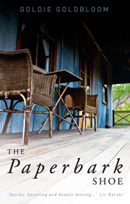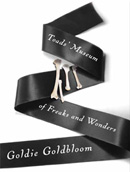


Freemantle Press, paperback, 9781921361630
Published in the U.S. under the title: Toad's Museum of Freaks and Wonders
New Issues Poetry & Prose, hardcover, 9781930974883
Goldie Goldbloom's debut novel, The Paperbark Shoe, serves as an example of the perseverance of the human spirit despite great adversity. Set in Western Australia during World War II, the story follows Gin as she endures great losses and makes great sacrifices while yearning for a happiness she seems unable to achieve.
Gin is an albino with crushed hopes of playing classical piano on the world stage. After spending months in a mental hospital, she marries Toad out of desperation - believing herself to be undesirable to any man. Gin joins Toad on his farming property in Wyalkatchem, Western Australia, where they lead a mundane lifestyle and struggle to live with horrific conditions. As the novel begins, Gin has already lost one child to diphtheria, and as it continues we learn more about the hardships that she and Toad have faced.
Into this atmosphere come Antonio and John, two Italian prisoners of war, who are offered to the couple as free labour. To Gin and Toad, they bring joy - a significant element missing from both of their lives. They also threaten to rip the family apart.
The book is filled with rich contextual detail, painting a portrait of Australian society during World War II. Conservative social attitudes are reflected, with racist stereotypes being commonly accepted. For example, as Toad reads from a newspaper article, "Twenty-one Jap planes bombed the blazes out of Drysdale mission... Killed a priest and a bunch of darkies. Shame about the priest but good riddance to our native friends say I." In addition, realistic portrayals of rural life, albinism and mental disease add another dimension to the novel, allowing it to be valued for its accurately depicted historical and physical setting.
Goldbloom crafts Gin's voice so carefully that it is nearly impossible not to feel as if you are prying into someone else's life. Her inner shame, desires and regrets are laid bare on the page for the reader to examine, ultimately allowing a great deal of empathy with the character. The other characters in the novel are also drawn beautifully, with each spoken word, action and piece of description contributing to the realisation of their own vivid personalities.
Some of the passages in the novel are incredibly dark, placing unavoidable images of death and decay in the reader's mind. One example is when Gin lists the numerous things she has learnt while living on a farm, starting with how to bake bread, but leading to "how to make a coffin, how to line it with pieces of cotton, how to dress a dead child, how to lower a coffin into the ground, how to put one foot in front of the other and keep on doing it every day". This is just one tragic piece of prose that illustrates Goldbloom's power over language.
Characters that are both complex and believable combined with beautiful prose and an interesting
historical setting make Goldbloom's book a great read. Enjoyable and emotional, The Paperbark
Shoe is a perfect debut.